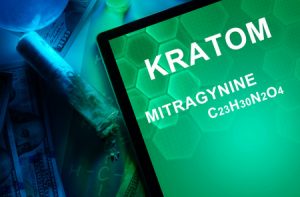Noose Tightening On Kratom
The “Noose Tightens Around Kratom” as the DEA and FDA continues to underscore concerns with the herbal product. The FDA warned consumers not to use kratom, as it effects mu receptors, the same receptors as opioids, and seems to have properties “that expose users to the risks of addiction, abuse, and dependence.” The DEA listed kratom as a “drug of concern” several years ago, but it continues to be unregulated and sold as an herbal supplement after the agency backed away from Scheduling it and limiting its ability to police it. See “Kratom: Part of the Problem or a Solution?” The FDA’s ability to regulate herbal products is limited to concerns with the safety of kratom and preventing vendors from making overt, unapproved health claims.
As a dietary supplement kratom is not subject to the same safety regulations as other drugs. However, the FDA has persisted in doing what it can to monitor companies that sell this herbal product and so-called “dietary supplement.” The FDA ordered a recall of some kratom products because of Salmonella contamination in April of 2018. In May of 2018 the agency accused three sellers of kratom products of making unapproved health claims.
The FDA continues to warn consumers not to use Mitragyna speciosa, commonly known as kratom, a plant which grows naturally in Thailand, Malaysia, Indonesia and Papua New Guinea. The FDA is concerned that kratom, which affects the same opioid brain receptors as morphine, appears to have properties that expose users to the risks of addiction, abuse and dependence. There are no FDA-approved uses for kratom, and the agency has received concerning reports about the safety of kratom.The FDA is actively evaluating all available scientific information on this issue and continues to warn consumers not to use any products labeled as containing the botanical substance kratom or its psychoactive compounds, mitragynine and 7-hydroxymitragynine. The FDA encourages more research to better understand kratom’s safety profile, including the use of kratom combined with other drugs.
MedPage Today noted the FDA included kratom on “import alerts” in 2012 and 2014, which allowed it to seize kratom and kratom products worth over $5.5 million in 2014 and 2016. Several suppliers reported having tons of kratom seized during that time. There were no further seizures for a while, but they seem to be sporadically occurring again as kratom companies adjusted their marketing strategies. A Denver company, Kratom Café USA, reported recently that its order of kratom was seized by the FDA. When the FDA began tightening its restrictions, the company revised its website. Kratom Café USA now claimed it sold kratom for aromatherapy and making candles. Despite the benefits section of their website having the following disclaimer, the FDA detained 540 kilos of kratom on November 30, 2018:
We make no claims that kratom cures, prevents or treats any disease or ailment. Keep this product out of the reach of children. Kratom is not a dietary supplement, but a precise amount of an ingredient sold as a raw materials and/or bulk herbs. All information provided has not been evaluated by the FDA, and all kratom products on this site are sold for horticultural, educational and scientific use.
But what is the real story? Nicolas Moodley, the owner of Kratom Café USA, said he thought the FDA’s action was “government overreach” and a violation of his rights. Besides, he added, it was taking a toll on his business. Moodley himself became dependent on opioids as the result of chronic pain from his work as a roofer. He credited kratom with relieving his pain and helping him kick the opioid habit. Now take a look at some of the Testimonials on Kratom Café USA:
Gabe T. said: “I love to use kratom for working out and for chilling out. Your powder is off the hook! I don’t mind paying a little more to get 5 time the potency and nearly lasts twice as long.” Richard G. said: “I have been using kratom for a few years now for anxiety and mood swings. It has worked okay from some head shops I buy from. The first time I used your product I was amazed how much more effective & smooth it is. Your kratom is the best I have EVER used.” This does not sound like Moodley’s customers are using kratom bought from him for aromatherapy and candle making.
An article published in Clinical Toxicology analyzed exposures to kratom reported to poison control centers (PCCs) in the U.S. from 2011-2017. Kratom exposure increased over fifty-fold, from 13 exposures in 2011 to 682 exposures in 2017. “Almost two-thirds (65%) of these exposures occurred during 2016-2017.” Most exposures were with adults 20 years old and above (65%) and most were with males (70.8%). Exposure rates by state were highest in Idaho and Oregon and lowest in Delaware and Wisconsin. “There were seven neonatal exposures reported during the study period and five were attributed to kratom withdrawal.”
Clinical effects observed for single-substance kratom exposures among the neonates included agitation/irritability, diarrhea, and hyperventilation/tachypnea. These neonatal withdrawal cases suggest that transplacental transfer is possible and that healthcare providers should educate pregnant women on the risks of kratom use during pregnancy. Notably, although not in a neonate, one exposure was documented as having occurred through breast milk. Thus, the possibility of exposure via breast milk should also be communicated to new mothers who use kratom.
The authors said the clinical effects observed during the study highlighted the fact kratom can have serious physiologic effects. Common non-opioid effects included tachycardia (21.4%), agitation/irritability (22.9%), seizures, and hypertension. More than one-third of exposures resulted in admission to a health care facility and more than half resulted in a serious medical outcome. “These high percentages reflect the potential toxicity of the active compounds found in kratom leaves.” And they highlight the need for kratom regulation by the FDA “to ensure quality and safety.”
Despite the perception that kratom is safe because it is classified as an herbal supplement, a variety of serious medical outcomes following exposure to kratom have been documented, especially when kratom is used in combination with other substances. More research is needed to define the human response to kratom. At a minimum, kratom products should be free of potentially harmful contaminants, provide a uniform strength of active ingredients, and have appropriate labeling. Increased regulation of kratom products would help guarantee product quality and safety. Individuals who choose to use kratom should be educated about its potential risks, including the dangers of using it in combination with other substances.
While there is no federal ban yet for kratom, a number of states and some smaller jurisdictions have banned its use. Currently there are six states where kratom is a controlled substance and thus illegal to sell, possess, use and grow: Alabama, Arkansas, Indiana, Rhode Island, Vermont, and Wisconsin. Several additional states have banned kratom in certain counties or cities. Others like Illinois and New Hampshire have set a legal age limit for its use.
Then on June 25, 2019, the FDA again issued warning letters to two additional marketers and distributers of kratom products, Cali Botanical and Kratom NC for illegally selling unapproved and misbranded kratom products. The companies claimed their products could treat or cure opioid addiction, withdrawal symptoms, depression, anxiety and even cancer. The FDA has also found high levels of heavy metals in kratom products. The Acting FDA Commissioner said “Despite our warnings, companies continue to sell this dangerous product and make deceptive medical claims that are not backed by science or any reliable scientific evidence.” Some examples of the claims being made by these companies include:
Kratom is frequently used as a natural alternative to treat depression, anxiety, addiction, diabetes, chronic pain and fatigue…Kratom has been reported to have taken the place of brand name drugs like Hydrocodone or Oxycodone for individuals, all the way to weaning people off of Heroin.Some researchers have even claimed that kratom can protect you against cancer!Kratom is used for energy, to increase attention/focus, to relax, and also to treat pain and addiction. Here is just some of what our customers have used kratom to treat . . . Chronic Pain, Migraines, Opiate Addiction, ADHD/ADD, Anxiety, Depression, Arthritis, Insomnia and much more!
There is an ongoing dispute about kratom-positive overdose deaths, with kratom advocates pointing to how the herbal supplement was not the only substance found in most decedents. In the Morbidity and Mortality Weekly Report (MMWR) for April 12, 2019 the CDC analyzed data from the State Unintentional Drug Overdose Reporting System (SUDORS) for July 2016 through December 2017. SUDORS records all substances detected on postmortem toxicology testing. The CDC analyzed overdose death where kratom was detected on postmortem toxicology testing and deaths where the medical examiner or coroner determined kratom to be a cause of death.
Kratom-positive deaths occurred in only 152 of 27,338 overdose deaths (.56%) for the time period of the study. “Kratom was determined to be a cause of death (i.e., kratom-involved) by a medical examiner or coroner for 91 (59.9%) of the 152 kratom-positive decedents, including seven for whom kratom was the only substance to test positive on postmortem toxicology.” However, the presence of additional substances could not be ruled out. And here is the rub: “Postmortem toxicology testing detected multiple substances for almost all decedents.” About 80% of the decedents with a kratom-positive and kratom-involved death had a history of substance misuse.
Focusing attention on the kratom-positive decedents who only used kratom appears to be a misdirection tactic. The problem seems to be individuals with a history of substance misuse who miscalculated on the strength or influence of the kratom they used—along with the other substances they ingested—and overdosed as a result of their mistake. Remember that in the Clinical Toxicology article, Post et al. concluded: “Despite the perception that kratom is safe because it is classified as an herbal supplement, a variety of serious medical outcomes following exposure to kratom have been documented, especially when kratom is used in combination with other substances.” The noose of regulation needs to get tighter around kratom and needs to occur sooner rather than later.


